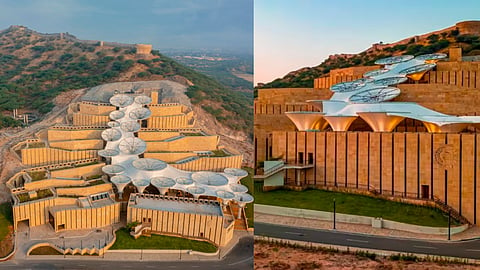
- HOMEGROWN WORLD
- #HGCREATORS
- #HGEXPLORE
- #HGVOICES
- #HGSHOP
- CAREERS
- ABOUT US
- CONTACT US

One of the most catastrophic calamities in Indian history, the Gujarat earthquake in 2001, left the entire nation in shock. Measuring 7.9 on the Richter scale, with Bhuj at its epicentre, it still evokes shivers down the spine of those who experienced it. The sheer scale of its impact is staggering, affecting 15,23,562 individuals in the Kutch district alone, resulting in the loss of approximately 12,932 lives, and affecting 890 villages.
The Smritivan Earthquake Memorial Museum serves two purposes — one as a memorial, and the second as a museum. It was built to honour the victims of the Gujarat earthquake in 2001 and, as a response to the act of taking life, the Smritivan Museum, intends to do the opposite — to give life to those immortalized by the museum. The themes of the museum revolve around rebirth and regeneration, and in this process, it memorializes those who passed away.
The institution stands as a symbol of resilience and hope; an antithesis to the destructive power that took so many lives. Instead of succumbing to grief, the museum seeks to rejuvenate and give new life to those who perished.
Conceived as the largest memorial and museum ever built in modern India, it sprawls over 470 acres. It stands atop Bhujiyo Dungar, a small hill on the outskirts of Bhuj, sharing the landscape with the centuries-old Bhujia Fort.
The very name, 'Smritivan', translates to 'Forest of Memories', encapsulating the institution's purpose as a space for reflection, remembrance, and rebirth. Unlike many memorials built in the shadow of tragedy, the Smritivan does not exist in response to the fear of nature's wrath. Instead, it intends to harmonise with nature, reflecting the culture of Bhuj, which has a long tradition of coexisting in harmony with its environment.
The Smritivan Museum's journey is rooted in its deep connection to Bhuj's unique heritage, culture, crafts, villages, and wildlife sanctuaries. It is not merely a museum; it serves as a civic space, where the community can congregate and celebrate their festivals. Recognizing the pivotal role such institutions play in city development, Rajeev Kathpalia of Vastushilpa Consultants, the architects behind the museum ensured that its architecture contributes to civic life; offering a green lung in the form of a park for the city.
The museum's design pays homage to the Rann of Kachchh; embracing the local climate and the resilience embodied by its people. It employs locally quarried Kawada Stone for cladding, a stone that mirrors the earth's natural colors. Even the waste from stone cutting is ingeniously repurposed for flooring, showcasing a commitment to sustainability and resource efficiency.
The central spine of the museum, in particular, serves as a civic space even when the galleries are closed. This space, marked by the changing seasons in its rooftop gardens, invites visitors to pause, reflect, and absorb the landscape. It is a place for temporary exhibits and performances, all of which comprise essential elements of a museum that promotes reflection and assimilation.The Smritivan Museum is designed for incremental growth, with modular galleries that ensure any extension aligns with the site's overall design.
The architectural approach to the steep hill on which the Smritivan stands is sensitive and respectful of the cultural heritage of the region. Instead of imposing a stark modern structure, it follows the natural contours in a way that is reminiscent of the fort wall that graced the hill for centuries. The result is a building that harmonizes with the land, offering a peripatetic journey and allowing visitors to connect with their surroundings in a distinctive way.
While standing as an antithesis to the act of taking life, the Smritivan Museum emerges not merely as a place of remembrance but as a living embodiment of the human capacity to overcome, rebuild, and thrive.
If you enjoyed reading this, here's more from Homegrown:
The 'Museum Of The Mundane' Is Archiving Personal Histories Through Materiality & Spaces
Visit A Chennai Museum That Is A Living Chronicle Of South Indian Traditions
A New Museum In Delhi Aims To Reflect The Pain & The Resilience Of Partition Survivors
